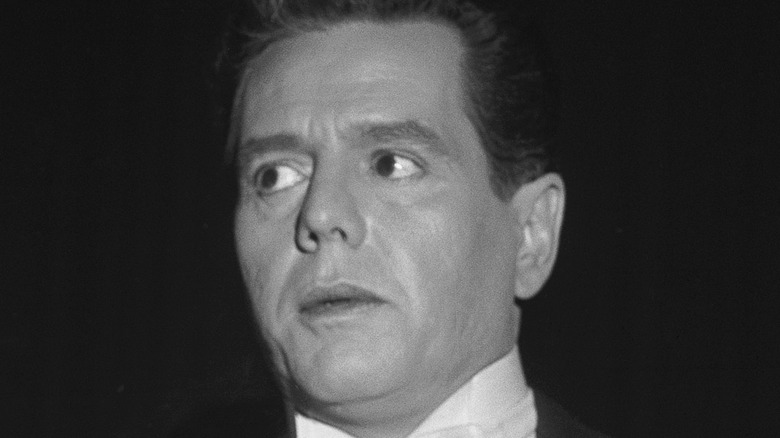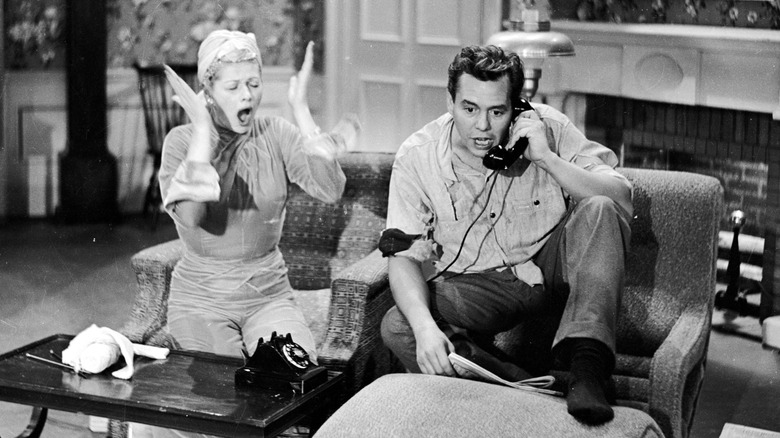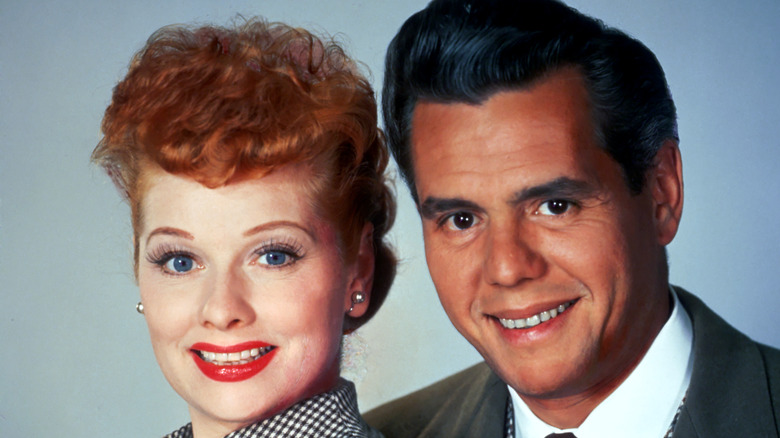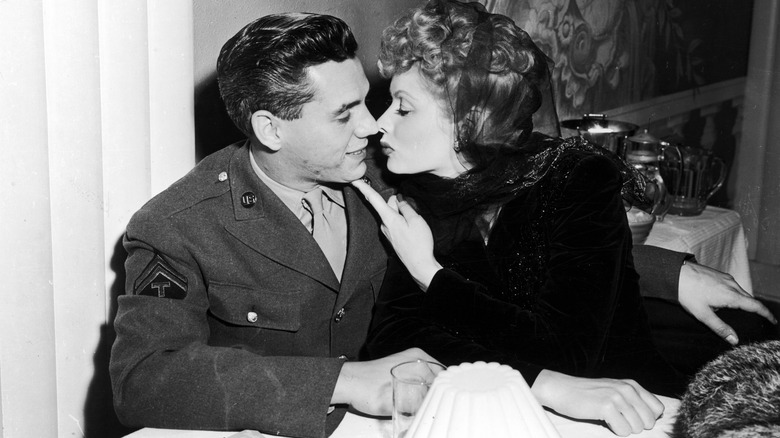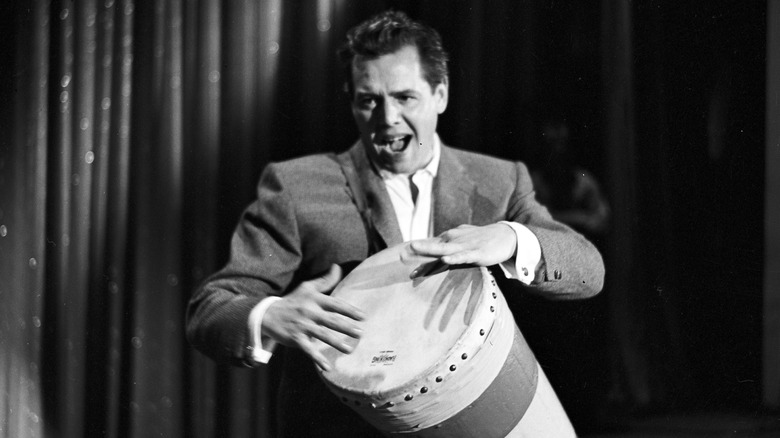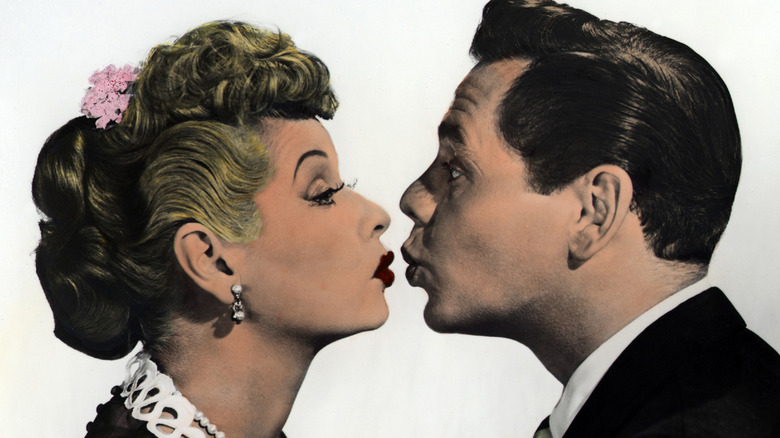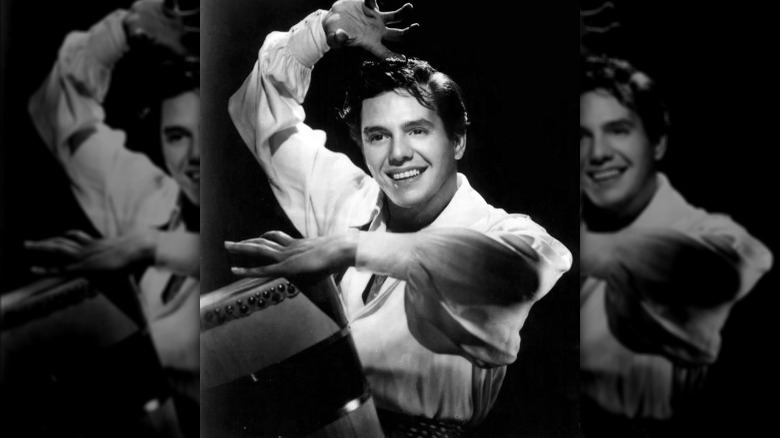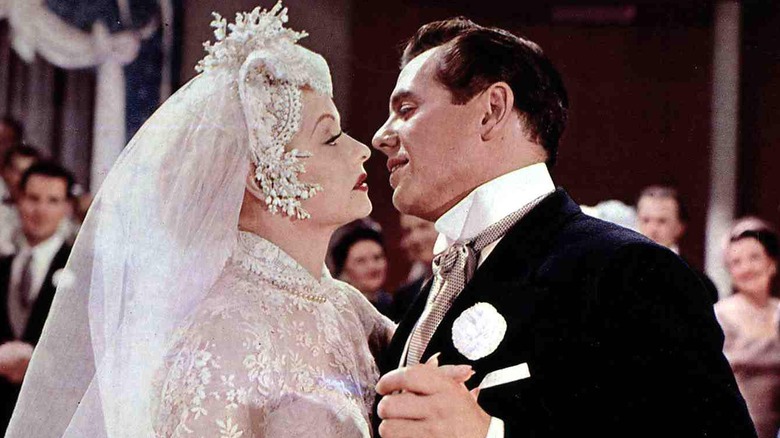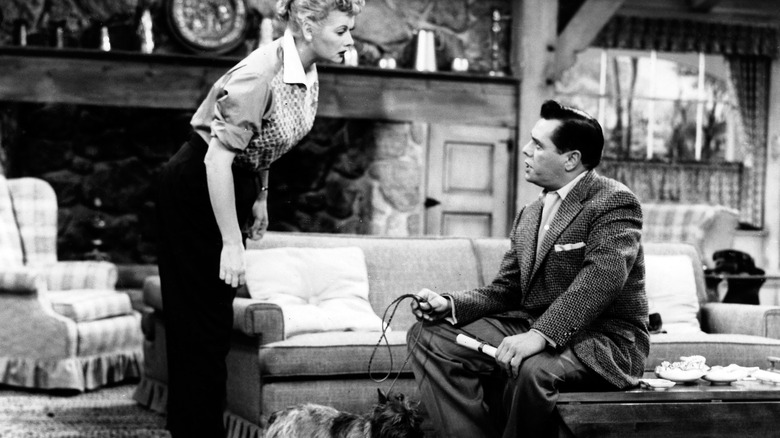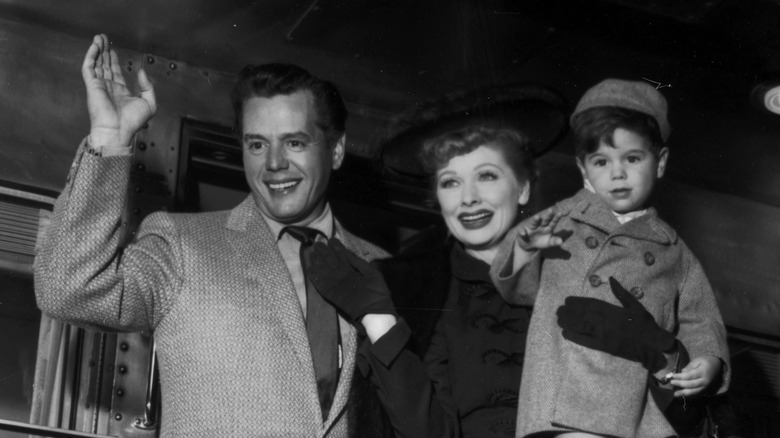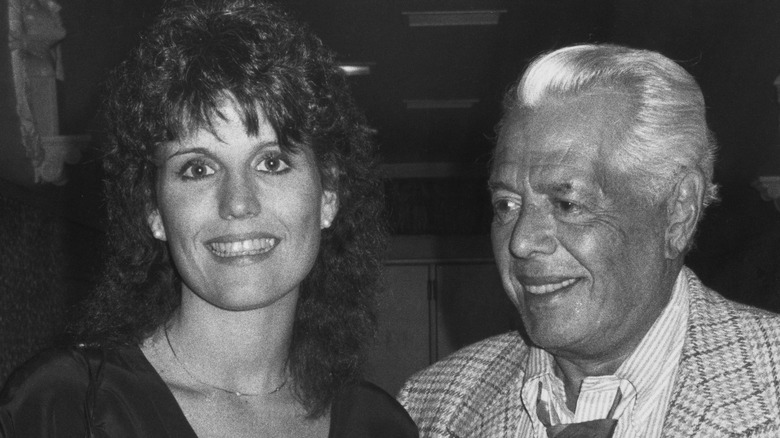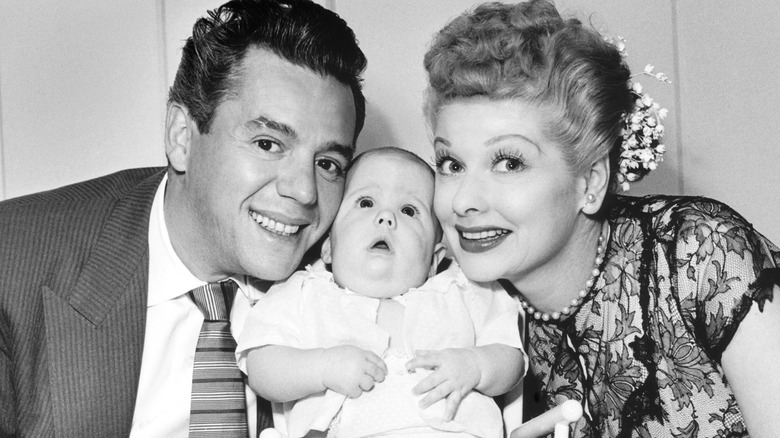The Untold Truth Of Desi Arnaz
It's hard to express just how wildly beloved "I Love Lucy" is. Even those who aren't devout fans have their favorite episodes, and the Library of Congress calls it "an American legend."
The show's final episode aired in 1957, but it wasn't really the end. Everyone's favorite couple went on to star in programs like "The Lucille Ball-Desi Arnaz Show," later known as "The Lucy-Desi Comedy Hour." Even when they weren't front and center on-screen, the influence of their company, Desilu Productions, Inc., was undeniable.
Alongside the iconic Lucille Ball was, of course, Desi Arnaz. The pair met when he was cast in the movie version of "Too Many Girls," a Broadway play he'd been in. One of the "girls" in the 1940 film was played by Ball, and they were married the same year.
What followed for him was a career at the head of the Desi Arnaz Orchestra and work alongside big names like Bob Hope. But by the late 1940s, Arnaz and Ball had set their sights on starring in a radio show of their own. That eventually transitioned to television, and although CBS executives reportedly doubted audiences would believe Ball and Arnaz were a married couple, the rest is history. Behind the scenes, though, there was a lot going on — a lot that's not as well-known as the success story.
He came from an upper-class family
After Lucille Ball and Desi Arnaz married, they bought a "starter" home that pretty much anyone would be jealous of. The Library of Congress reports that it was a ranch in a rural area of Los Angeles, and it came with five acres and a pool. Arnaz called it a "ranchito," or "little ranch."
If you're wondering why a five-acre ranch seemed small to him, his background offers some clues. Arnaz was born Desiderio Alberto Arnaz III, y de Acha on March 2, 1917. His father's obituary in The New York Times notes that the elder Arnaz was the mayor of Santiago de Cuba for a full decade, and that he was also a congressman for Oriente Province. The Daily Telegraph goes into more detail about Arnaz's family, reporting that Arnaz had a maternal grandfather who was an executive at Bacardi Rum.
In 1927, the bottom fell out of Cuba's agricultural market — particularly, sugar. That led to protests and the subsequent arrests of people who opposed then-president Gerardo Machado, under whose patronage Arnaz's father had served. When Machado fled to the U.S. in 1933, Arnaz's father was arrested, and the family's property was confiscated. He was released after six months and headed to the U.S. as well.
It wasn't until 1935 that Desi Arnaz joined his father in Miami, where he learned English and held down some odd jobs before falling in with an orchestra led by Xavier Cugat. (It's worth noting, though, that there are some discrepancies here. According to Biography, the younger Arnaz left Cuba in 1933 as well.)
Secret houses, secret families, secret mistresses... they were all the norm
While researching his novel "The Queen of Tuesday," Darin Strauss found that Lucille Ball had a very good reason for standing her ground and insisting that Desi Arnaz be cast as her husband on television: She wanted to keep him close and stop his cheating.
Strauss wrote in Vanity Fair that even before "I Love Lucy," Arnaz was a notorious womanizer whom one reporter described as having "sprinkled his affections all over Los Angeles." Ball had already threatened to divorce him but didn't. There's more to this story, but it's worth looking at one observation made in the tabloid Confidential, which reported: "He comes from a land, Cuba, where the men are torrid and the ladies, allegedly, are glad of it."
If that sounds cringey, here's the thing: According to The Daily Telegraph, Arnaz had spoken pretty openly about just how his father's family dealt with the idea of fidelity within marriage. His grandfather, Arnaz revealed, kept two separate houses, and one was for his mistress.
After saying that his grandmother probably knew about the other woman and that his grandfather's mistress was perfectly fine with having to hide whenever his grandmother came around, Arnaz explained: "As long as he continued to love each of them, and cared for their children equally, they were satisfied. Having two houses and two sets of children was common among Latin men of means, and Latin women understood this and didn't make a fuss."
Declared medically unfit for overseas deployment, he served elsewhere
Among Desi Arnaz's early films were war movies like "Bataan," and according to The National WWII Museum, it wasn't just an act. He was drafted in 1943, in the middle of World War II.
The museum suggests that his military service helped get his citizenship pushed through. Arnaz didn't just become a U.S. citizen in 1943 — that's also when he officially changed his name from Desiderio to Desi. As a result, his military records — which are available online at the National Archives — are in both names.
Arnaz was ultimately found to be physically unfit for active duty, and a look at his medical exam record gives a hint as to why. Those drafted into the military were examined for things like eye, ear, and nose abnormalities, hernias, and any possible heart or lung conditions. The only medical note on Arnaz's record is under "Musculoskeletal defects," which reads "Genu valgum."
According to Healthline, that's a condition more commonly called knock-knees, and it's where a person's knees are misaligned and bend inward.
Disqualified from active duty, Arnaz was stationed in California, where he was attached to the military's entertainment units. Interestingly, there are few details about exactly what he did during the war, aside from a mention that he was made an "entertainment director."
Desi Arnaz brought the conga to the U.S.
The conga is a dance that's super accessible to everyone — even those who have no rhythm. That's the brilliant thing about it: Everyone can join in, and while it's been danced in Cuba for a long, long time, it wasn't until Desi Arnaz set foot in Miami that Americans started doing it, too.
That's according to Arnaz's daughter, Lucie (via Outsider). She said Arnaz had gotten into the music industry not entirely because he wanted to, but because he and his father were living in a warehouse and needed a way out. For Arnaz, that way out was music. It wasn't all smooth sailing, though. Lucie recalled him saying that, after being hired by a band and then breaking away to do his own thing, he had started dancing the conga because he was desperate to make it in the industry.
"That really was his ticket," she said in an interview. "He became quite famous for that, and playing the conga drum, and doing this conga dance in the conga line."
That's when he headed to New York, and the dance became so popular that he ended up working at a club named after it (La Conga). It was during his stint at La Conga that Arnaz was discovered by Broadway songwriting duo Rodgers and Hart, who cast him in "Too Many Girls."
He wooed Lucille Ball with a dance... after being disgusted by her
Lucille Ball and Desi Arnaz might be among the most iconic couples in the entertainment industry, but it wasn't love at first sight. According to what biographer Warren G. Harris wrote in "Lucy & Desi: The Legendary Love Story of Television's Most Famous Couple" (via Vanity Fair), it was quite the opposite.
Arnaz was reportedly pretty repulsed by Ball the first time he saw her. He was having lunch with the head of RKO Studios when Ball walked up, fresh off the set of "Dance, Girl, Dance." How fresh? She was still wearing her torn dress and full makeup from the scene that she'd just filmed with Maureen O'Hara, which happened to be a fight scene.
It wasn't until she ditched the makeup and they met again later that Arnaz admitted she was the right one to play his love interest in "Too Many Girls." The story Harris recounts is that Arnaz asked Ball if she knew how to do the rumba. After demonstrating twice for her, he simply said, "You're going to have to rumba in this picture. I can teach you quickly, but only on condition that you go out with me tonight."
It wasn't long before they eloped, and Ball would later say, "I never fell in love with anyone quite so fast. ... I knew I shouldn't have married him, but that was one of the biggest attractions."
Luck made him miss a devastating accident
In 1959, Buddy Holly, Ritchie Valens, and the Big Bopper were killed in a plane crash — a tragedy now known as "the Day the Music Died." Waylon Jennings was originally supposed to be on the plane, but he gave his seat to the Big Bopper at the last minute. Valens wasn't supposed to be there, either, and only died because he'd won a seat on the plane in a coin toss.
What does this have to do with Desi Arnaz? Something eerily similar happened to him. According to the Akron Beacon Journal, it was July of 1947, and Arnaz — along with his orchestra — was in the middle of a national tour. Lucille Ball often made it a point to be at Arnaz's shows, but scheduling hadn't made it possible. After wrapping a show in Madison, Wisconsin, on July 7, Arnaz and his manager (who was also his brother-in-law) decided to send the rest of the band on to their next stop in Akron, Ohio, on a charter bus. Meanwhile, they were going to take a quick detour to Detroit to see Ball in a touring play.
The orchestra's driver fell asleep at the wheel, and the vehicle was hit by a truck. The bus came to a stop and caught fire.
Many of the trapped band members were freed by the truck driver, who hacked his way in with an ax. Some of the injuries were catastrophic: One man lost an eye and was partially paralyzed. The worst among the injured? The men who had moved up into the seats left empty by Arnaz and his brother-in-law.
Desi Arnaz had a complicated faith
When the Jewish Museum of Maryland looked at "I Love Lucy" through the lens of faith, they found some surprising layers — starting with the fact that Lucy's maiden name was nearly Teitelbaum. (The writers ultimately went with McGillicuddy.)
In real life, Ball was Protestant — and Arnaz's family were devout Catholics. They were so devout that, when the first few years of marriage didn't produce a kid, Arnaz's mother insisted that they get remarried in a Catholic ceremony in order to make their union complete before God.
The museum also reports that the Arnaz family had at least some connection to the Afro-Caribbean religion Osha, or Santeria. According to the BBC, Santeria was once strictly oppressed by the Cuban government but has seen a resurgence. Interestingly, that brings up the catchy tune "Babalu," which became Arnaz's signature song. According to Smithsonian Magazine, the subject of the song, Babalú-Ayé, is a Santeria deity connected to the Catholic St. Lazarus. While Lazarus is the patron saint of the sick and is seen in Cuba as a figure capable of working miracles, Babalú-Ayé both causes and cures illness. He was blamed for spreading epidemics such as smallpox and AIDS — and for healing people afflicted with those diseases.
He completely overhauled the way television was done
Today, people are pretty used to the way television sitcoms are produced and shown. There are several cameras and often a live audience, and once they've aired, episodes continue to be shown over and over again, raking in a pretty penny. (Fox Business estimates "Seinfeld" creators Larry David and Jerry Seinfeld make somewhere around $400 million a year on syndication rights.)
Without Desi Arnaz, though, that business model would look pretty different.
NPR business correspondent Sonari Glinton took a look at just what kind of contributions Arnaz made — after Glinton heard that Arnaz designed and built the apartment building he'd just moved into. Glinton found that Arnaz started by insisting that, instead of the more traditional single-camera setup, they use three cameras to film "I Love Lucy." When the higher-ups dragged their feet, Arnaz promised to front the cost for the cameras and production, but in return, he and Ball would retain ownership of the shows.
The studios agreed, and Glinton says it was a while before Arnaz hit upon the idea that they could broadcast episodes again — and charge networks for the right to show them. With one brilliant business decision, he invented reruns and syndication, changing the way the television industry worked.
Arnaz and Ball ultimately sold "I Love Lucy" for enough money to launch their own Desilu Productions, and in turn, started putting out new, ground-breaking television that included shows like "Star Trek" and "Mission: Impossible."
Lucille Ball knew about all his other women
The real-life marriage of Lucille Ball and Desi Arnaz was always rocky, and it almost ended well before the show even aired. According to Ball's autobiography (via the Los Angeles Times), she was already lamenting the fact that Arnaz had stopped coming home at night by 1944. She was thinking about divorce, but the pair reconciled. Arnaz, however, would continue to make tabloid headlines for decades. When Confidential ran a 1955 story on all of his affairs, Arnaz was given an advance copy, and Ball read it. Her response? "I could tell them worse than that."
People spoke with some of those who knew Ball and Arnaz best. The interviews verified the stories and confirmed that Ball knew about Arnaz's infidelity. According to People, co-star Keith Thibodeaux (Little Ricky on "I Love Lucy") said he frequently heard the couple arguing when he was visiting their home.
Thibodeaux also recalled incidents like the one that unfolded at a Palm Springs country club. His father and Ball — old family friends — were having a drink together when Arnaz walked in with a girl on each arm. He saw Ball and immediately walked out.
He got sober the year before he died
"I Love Lucy" writer Bob Weiskopf told People that although Desi Arnaz didn't drink when he was on set, alcohol formed the backdrop to pretty much everything that he did. Associated Press reporter Jim Bacon recalled numerous occasions that involved Arnaz getting drunk and hiring sex workers.
By the time divorce papers were filed, Arnaz's reliance on alcohol — and all that went with it — was one of Ball's major complaints. Others saw it, too: When Arnaz was tasked with helping the widow of his old friend, Jimmy Durante, plan his funeral, he was so drunk that he kept inviting people who were long dead.
People also reported that Arnaz finally did get sober. According to his daughter, Lucie (pictured, with him), Arnaz had long refused to get help for his heavy alcohol use. "He resisted going into AA or any program for a long, long time," she explained. "We don't air our dirty laundry in front of other people; he hated that part. But he finally did after his wife Edy died."
It was Desi Arnaz Jr. who finally convinced him to stop drinking, and Lucie recalled: "I was right next to him when he stood up and said, 'My name is Desi and I'm an alcoholic.' It was the proudest moment of my life to sit next to him and hear him do that."
If you or anyone you know is struggling with addiction issues, help is available. Visit the Substance Abuse and Mental Health Services Administration website or contact SAMHSA's National Helpline at 1-800-662-HELP (4357).
Their daughter has revealed Desi Arnaz's last words to Lucille Ball
Desi Arnaz and Lucille Ball divorced in 1960. According to Biography, that was followed by his sale of his share of their production company, Desilu. He ultimately remarried, as did Ball.
Their daughter, Lucie, worked with Amy Poehler on her documentary "Lucy and Desi," and she shared some intimate details of the last days of her father's life (via Insider). Lucie recalled that it wasn't long after he was diagnosed with lung cancer that she called her mother and said, "I think you should talk to him, don't know if he's going to be awake much longer. So, if you want to say anything at all, now's a good time."
Lucie held the phone for her father, and she revealed her mother's last words to him: "I love you, I love you, I love you, I love you... I love you." Arnaz replied, "I love you, too, honey."
The last time they spoke was on November 30, 1986 — their wedding anniversary. Arnaz died a few days later, on December 2. Ball had come to visit about a month before that, around the time that Arnaz had declined to undergo any more cancer treatments. Lucie recalled seeing them sitting together, watching episodes of "I Love Lucy" that she had put on for them. "I could hear them laughing together," Lucie recalled. "And then she left, she went home. And she told me she cried all the way home."
